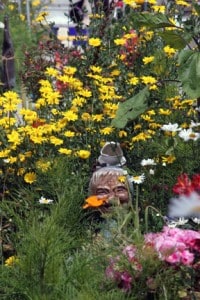
Sunflowers are easy to grow from seed. A package costing less than $3. will grow into a cheering row of bright yellow blooms.
Everyone is worried about the economy, and we’re all finding ways to save money. Being thrifty is fine but don’t let prudent money matters keep you out of the garden. The garden is a place for relaxation and renewal, and these days we need all the stress relief we can get.
There are many ways to garden on a budget, and the first comes in early spring. This season, consider growing some of your annuals from seed. A package of seeds costs about the same as a six-pack of annuals, but that packet holds dozens, sometimes hundreds of potential plants.
The easiest annuals to grow from seed can be planted directly in the ground once all danger of frost is past. Zinnias, cleome, cosmos, alyssum and nasturtiums can be planted directly in the garden, or in flats or pots. Success depends on keeping the ground or potting soil damp while the seeds germinate and the plants are small. As the annuals grow, taper down the watering until you are watering them deeply twice a week.
Perennials often take longer to grow from seed, but Echinacea and Rudbeckia are usually easy to sprout. Biennials such as foxglove and Verbascum are also reliable about growing from seed. Those who don’t want to grow perennials from seed can save money by purchasing small plants.

Go on, have fun in the flowerbed! That ugly vase that your aunt gave you? That suitcase that has been moulding in the attic? Perfect for the garden!
Most garden centers stock small potted perennials at the start of the season. If these are put into loosened garden soil that has been amended with compost or composted manure, most plants will double their size in the first season. If small perennials can’t be immediately placed in the garden, put them in a larger pot with fresh potting soil and they will grow larger because they have more room for roots.
Other gardeners are another source for plants when the budget is tight. Most gardeners are happy to share self-seeded plants or perennials that need dividing. I know of annual plant-swaps that are held around the country where gardeners come together to trade plants and ideas every spring. If you want to start such a tradition, contact local garden clubs or put a notice on craigslist.
Once your garden is planted, save on water bills by watering deeply less often. Once young plants get established, usually in three to four weeks, water your garden deeply but less often. Use soaker hoses or sprinklers, but don’t hand water: hand watering only soaks the soil down a couple of inches, not enough to last. You’ll use less water in the long run if you water deeply because the plants will grow deep roots and will be able to go longer between soakings.
If there is a pile of old leaves on your property, you have the ingredients for a wonderful, free mulch. If the leaves are still crispy, run over them with a lawn mower when you mow the lawn the first time this spring. Use the chopped leaves mixed with lawn clippings to cover the soil around annuals, perennials and shrubs. Decayed leaves can be placed directly in the garden.
After planting and mulching you can get your artistic juices going by raiding the garage, attic and basement potential garden ornaments. That old basket or metal farm equipment might be just the thing to add interest to the perennial bed. Assorted clay pots can be stacked to create a tall planter: stick a metal or wooden rod through the holes to keep the stack from toppling, and end with an upright pot that you can fill with soil and plants.
We may not be able to singlehandedly turn the economy around, but we can use the current climate creatively. The Dow Jones may be down, but gardening is always up.
